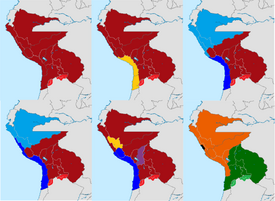United Restoration Army
| United Restoration Army | |
|---|---|
| Ejército Unido Restaurador | |
| Active | 1837; 1838–1839 |
| Allegiance |
|
| Branch | Chilean Army Restoration Army of Peru |
| Type | Field army |
| Engagements | War of the Confederation Iquicha War of 1839 |
| Commanders | |
| Chief Generals | Manuel Blanco Encalada (1837) Manuel Bulnes (1838–39) |

- Controlled by the United Restoration ArmyNew Peruvian StateNew Bolivian StateControlled by the United Restoration Army during the restorationDe facto borders after the dissolution
The United Restoration Army, also called simply as the Restoration Army, was a land military force that operated between the years 1837 and 1839, which had the objective of ending the Peru-Bolivian Confederation, led by General Andrés de Santa Cruz, and restore the independence of Peru to its situation prior to the Salaverry-Santa Cruz War.
This military force was made up of the Chilean Army and the army of the dissident governments formed in Peru, first that of Antonio Gutiérrez de la Fuente in 1837 and then that of Agustín Gamarra between 1838 and 1839. Its first commander was Manuel Blanco Encalada in the failed expedition of 1837. During the second expedition of 1838-1839, Manuel Bulnes Prieto was appointed as its general in chief.[1][2]
Among its members were the North Peruvian military and politicians Juan Crisóstomo Torrico and Ramón Castilla, among others, who were exiled in Chile. There were also General Manuel Ignacio de Vivanco, Andrés Martínez and the politician Felipe Pardo y Aliaga, who negotiated the deal with Chile to intervene in favor of the North-Peruvian State, joining forces in order to break the Confederation.[3] Likewise, former North Peruvian president Agustín Gamarra and his followers were also refugees, who finally formed an alliance with Chile in 1838 to establish a new government in Peru. After the war, the military campaigns were paid by Peru to the government of Chile.[4]
The defeat of the Peru-Bolivian Confederation occurred in the town of Villa de Yungay, in the Department of Huaylas on January 20, 1839.[5] In commemoration of this victory, the Department of Huaylas took the name of the Department of Ancash, as it is known today.
Later the term was used again during the Peruvian revolutions where one of the parties called restoration to the cause they defended, such was the case of the revolution led by General Mariano Ignacio Prado in 1865.[6][7]
See also
[edit]References
[edit]- ^ Villalobos Rivera, Sergio (2002). Chile y Perú. La historia que nos une y nos separa 1535-1883 (in Spanish). Santiago: Editorial Universitaria. p. 53. ISBN 978-956-11-1601-6.
- ^ Documentos relativos a reclamos al gobierno del Perú sobre propiedades britanicas tomadas por autoridades peruanas, desde 1835 hasta 1839. Peru. 1840. pp. 72–73.
- ^ Tamayo Herrera, José (1985). Nuevo Compendio de Historia del Perú. Editorial Lumen. pp. 255–256.
- ^ Convención celebrada con el gobierno de Chile para el pago de la deuda peruana, de 11 de diciembre de 1849 (PDF). 1849. Archived from the original on 2007-09-27.
- ^ Varas, José Antonio (1870). Recopilacion de leyes i decretos supremos concernientes al ejército, desde abril de 1812 a [diciembre de 1887] ...: Abril de 1812 a abril de 1839 (in Spanish). Santiago: Imprenta nacional. pp. 520–521.
- ^ Dávalos y Lissón, Pedro (1926). "XIII: San Román y Pezet". La primera centuria: causas geográficas, políticas y económicas que han detenido el progreso moral y material del Perú en el primer siglo de su vida independiente (in Spanish). Vol. IV: Causas políticas y económicas. Lima: Librería e Imprenta Gil. p. 143.
- ^ Peralta Ruiz, Victor (2018). Guerra internacional, revolución y dictadura: los partidos parlamentarios y la política peruana entre 1865 y 1867 [International War, Revolution, and Dictatorship: Parliamentary Parties and Peruvian Politics between 1865-1867] (in Spanish). Pontificia Universidad Católica del Perú. p. 97.
